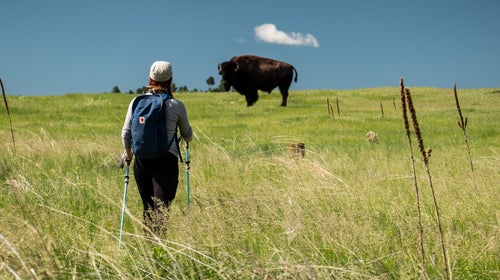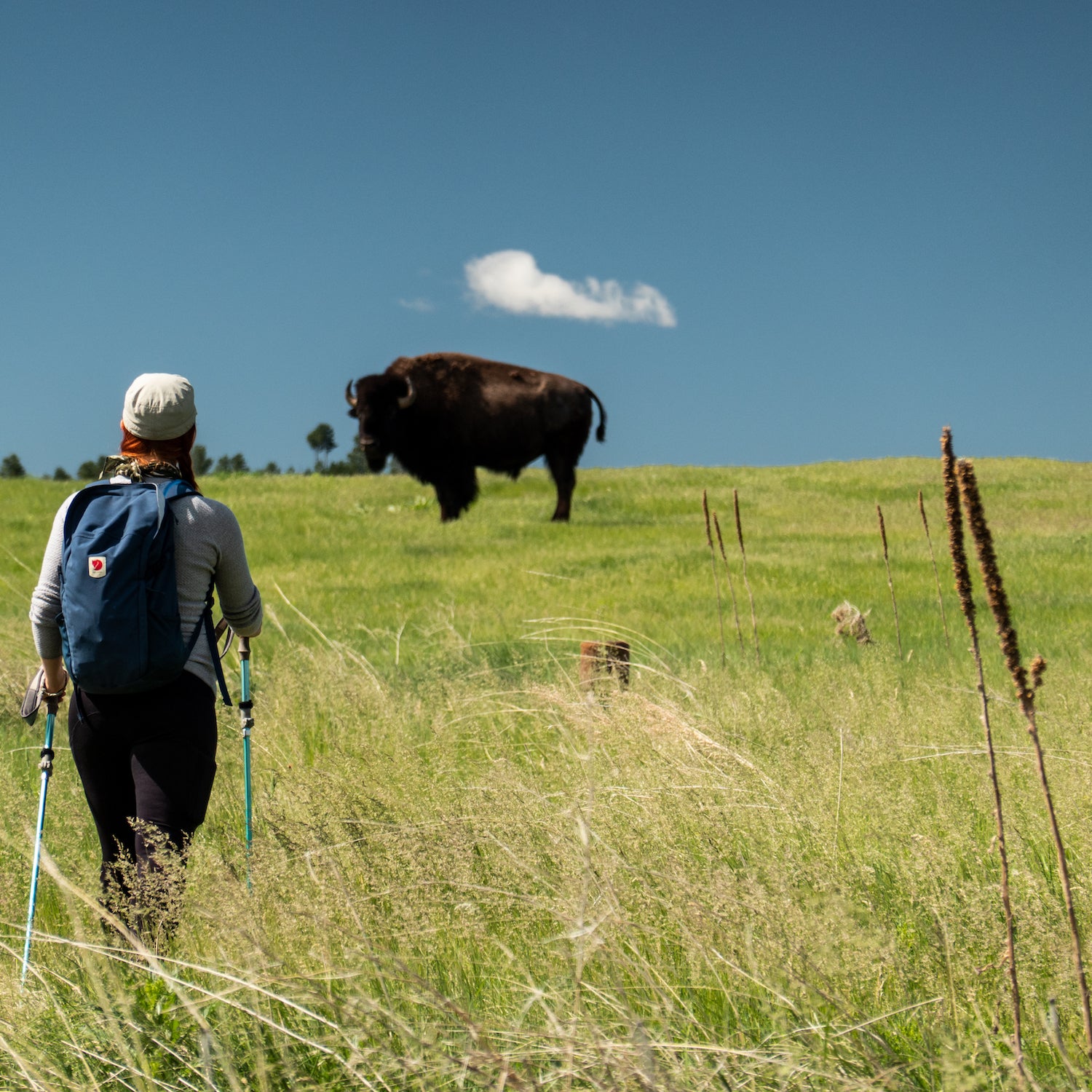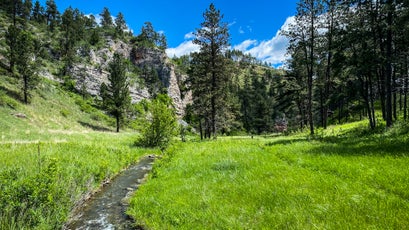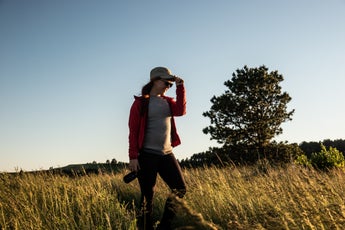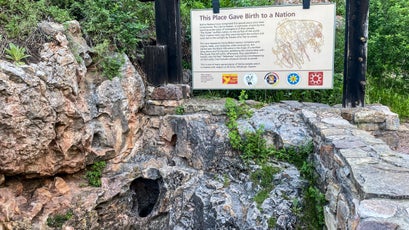62 Parks Traveler started with a simple goal: to visit every U.S. national park. Avid backpacker and public-lands nerd Emily Pennington saved up, built out a tiny van to travel and live in, and hit the road. The parks as we know them are rapidly changing, and she wanted to see them before it’s too late.
Pennington has returned to traveling and is committed to following CDC guidelines during the COVID-19 pandemic to ensure the safety of herself and others. She’s visiting new parks while closely adhering to best safety practices.
It was cool and quiet when I arrived at Wind Cave in South Dakota, a sunset glow kissing the grassy hillsides. I parked my van at a picnic area near the park’s visitor center and ambled down a short gravel path into a shallow canyon. At the end of my brief stroll, I held my palm gingerly over a gaping hole in an otherwise solid rock wall. As if by some ancient wizardry, a chilly breeze blew out of the rocky ground, dancing between my fingertips—the famous wind of Wind Cave.
Long before a gust knocked Jesse Bingham’s hat off his head while hunting here in 1881, prompting him and his brother to stumble upon this vast cave system, the cave’s natural opening had been regarded as a sacred site for the Lakota people. It’s the place from which they believe they emerged from the earth, a legend that has been passed down for centuries. Today the site is known to modern Lakota as Maka Oniye, or “breathing earth,” a portal to the spirit world.
Usually park visitors can see the system by taking an elevator down into the caves or hiking through the natural entrance with a ranger. Unfortunately, it closed in July 2019 due to elevator issues, and now remains closed because of the COVID-19 pandemic. So this small, historic opening was all that I could see of the park’s namesake caverns. There would be no thatched boxwork mineral deposits or delicate stalactites in my immediate future. Ever the resourceful traveler, I took the closure as a challenge to explore the unsung wonders of this national park—notably its 30-plus miles of hiking trails through one of the largest remaining mixed-grass prairie ecosystems in the country.
The next day, I set an alarm and got an early start to hike the Lookout Point/Centennial Trail Loop, a 4.5-mile trek through rolling green hills, prairie dog towns, ponderosa pine forests, and craggy, creekside canyons. As a California hiker unaccustomed to big game on the trail, I found myself tremendously anxious about the prospect of bison encounters. I had never seen one in the wild and only had a vague idea about what I should do if I came across a bison jam en route.
As with most things in life, Mother Nature tends to sort out our fears with a hearty dose of immersion therapy. Just ten minutes into the hike, I rounded a corner to find a 2,000-pound bull casually grazing in the middle of the trail. I stopped dead in my tracks and began laughing. Of course this is the first thing I see today, I thought.
Taking a deep breath, I carefully scanned the ground for prairie dog holes and tiptoed as gracefully as I could in a wide semicircle around the fuzzy beast. I felt invincible.
After my death-defying run-in with an ice-age-era mammal, the rest of the hike was a snap. I dodged thick poison ivy as I cruised downhill through the forest and hopped across the lush, riparian landscape surrounding Highland Creek, passing rugged, rust-colored limestone cliffs and smiling all the way back to my van.
The day may not have featured the thousand-foot cliffs of Yosemite or the rocky alpine peaks of Glacier, but sometimes an unknown hike doesn’t need the usual fanfare to make you feel accomplished. Sometimes all it takes is a welcome surprise.
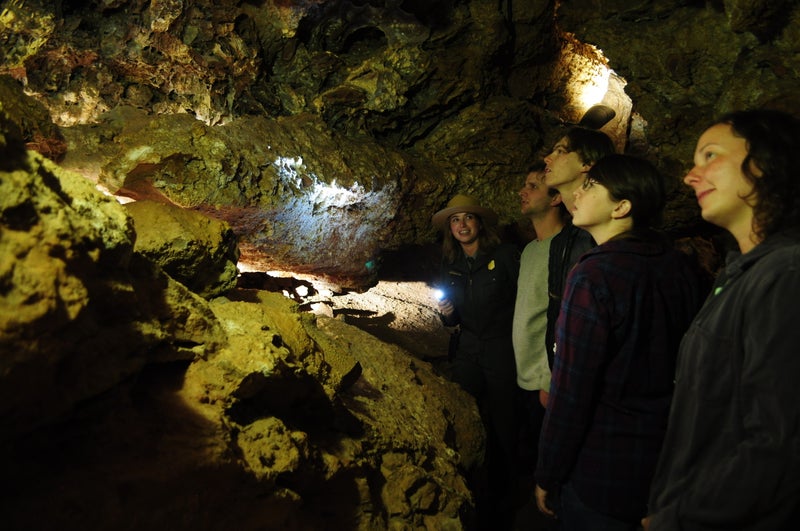
62 Parks Traveler Wind Cave Info
Size: 33,847 acres
Location: Southwestern South Dakota
Created In: 1903 (national park)
Best For: Caving, night-sky viewing, hiking, scenic prairie drives
When to Go: Spring (23 to 67 degrees), summer (49 to 84 degrees), and fall (23 to 75 degrees) all provide proper weather for roaming the park’s vast trails and prairies. Winter (13 to 41 degrees) is chilly, and snow sometimes forces park roads to close. The cave system’s temperature remains a steady 54 degrees year-round.
Where to Stay: Wind Cave is located a short drive from Hot Springs, South Dakota. For those not looking to camp at the park’s only campground, Dollar Inn Hot Springs is a great budget option full of clean rooms. Breakfast is included.
Mini Adventure: Hike the easy one-mile Prairie Vista Trail, and check out Wind Cave’s natural opening. Along the way, learn about the history of the Lakota people, and experience the amazing biodiversity of a mixed-grass prairie landscape.
Mega Adventure: Go spelunking. Once the cave reopens (a date has yet to be announced, but you can check the National Park Service’s site for updates), the park will begin offering its famous tours once again. The most adventurous of the bunch is the four-hour Wild Cave Tour, in which visitors crawl through tight passageways and explore its undeveloped areas.
